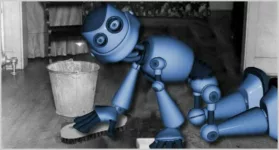Cleaning with laser light – not science fiction
A German company, cleanLASER GmbH, has developed portable laser devices than clean metal surfaces from rust, paint or residue.
When I first saw the video below I thought it was a hoax.
Two german laser scientists: Dipl.-Ing. Edwin Büchter and Dr. Winfried Barkhausen, founded the company in 1997. Apparently cleanLASER is the first manufacturer to offer mobile fiber-coupled laser cleaning units, ranging from 20 to 1000 Watts laser power. According to the company it works as follows:
-
Powerful, very short, rapid and moving laser pulses produce micro-plasma bursts, shockwaves and thermal pressure resulting in sublimation and ejection of the target material.
-

-
-
A focused laser beam precisely vaporizes the target coating or contaminant.
-
Process optimization of the laser beam produces maximum reaction with the target material for speed while, at the same time, does so safely and without harm to the base material.
-

-
- Metal surfaces are well-suited for many laser cleaning applications. Optimized beam settings will not metallurgically change or damage the laser treated surface. Only the coating, residue or oxide targeted for removal is affected as the laser beam is precisely adjusted not to react with the underlying metal surface.
-
Laser beam power density is accurately and easily adjusted to achieve cleaning results impossible with all other options.
Laser cleaning can also be used for restoration, it works by using extremely short duration pulses of laser light, scanned across the surface to vaporize soil, carbon deposits, oxides with other organic and inorganic contaminants. A fume extractor is used to capture the vaporized residues, leaving a clean, dust-free surface.
Apart from cleaning surfaces the technology can also be used to provide tamper proof, non-wearing labeling for metals and plastics alike.

And for those who can afford the $50,000 to $500,000 price tag, you can also clean your fingernails.
Trust the Germans to use lasers for practical, productive tools instead of making weapons and death stars.








